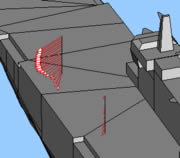
Topology of the air flow on the ship's surface. |
These tests have many purposes. Firstly, the helicopter pilots need to know the air flows accurately. The presence of an area of turbulence or a side wind is detrimental to a good deck landing. The wind tunnel tests are used to determine the easiest flight paths for the helicopter, avoiding the disturbed areas. They are also used to locate the plumes due to the ship's propulsion. Then, the areas without plumes can be chosen for the crew’s fresh air intake. The last objective concerns the anemometry. In order to find out the windspeed and direction, the ship is equipped with anemometers and wind vanes, but the motions of the air disrupt these measurements. Precise knowledge of the aerology can be used to correct them and therefore accurately determine the wind's real speed.
A ship's aerology is very different from that of an aircraft. Firstly, because of the presence of water: "At water level, the wind's speed is zero and it increases progressively between zero and several dozen meters in height", explained Christophe Verbeke, test engineer at Onera in Lille. Another difference is that in the wind at the boat's level is a combination of the real wind and the boat's speed and is often complex. All these details must be taken into account during the tests.
This is the first projection and command ship for the French navy. Therefore, the results of the aerology studies are particularly important for the ship's future users. "It's quite a squat ship, with high and elongated parts, which create areas that are very much disrupted by cross winds", observed Christophe Verbeke. Therefore, under these wind conditions, certain maneuvers must be avoided. "We specified that the exhaust should be altered because it caused problems of exhaust fumes blowing back onto the ship", he indicated. "We recommended a lattice structure rather than a fairing." In the next few years, these studies should be useful not only in operational terms but also in the ship's design phase: "Early next year, we will propose a thesis on the control of aerological phenomena, indicated the engineer. "By making certain parts discrete, you can reduce the vortices, which means that you can operate in much less unfavorable conditions." |
![Une maquette de bâtiment de projection et de commandement [BPC] en situation dans la soufflerie L2 de Lille](/sites/default/files/actualites/magazine/zoom_in_the_lab/32-bpc-soufflerie-l2.jpg)






